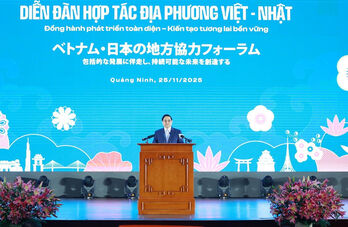.jpg)
Illustrative image (Source: VNA)
According to the Ministry of Industry and Trade, in October, Vietnam shipped abroad 700 tonnes of rice for 433 million USD, a 27% rise in value compared to the same time of 2022.
The result pushed the total rice export volume in the first 10 months of this year to 7.1 million tonnes with a value of nearly 4 billion USD, up 17% and 35% year on year, respectively.
The Vietnam Food Association (VFA) reported that as of November 1, Vietnamese rice had recorded the highest price among major world suppliers.
However, VFA Vice President Do Ha Nam held that high price is not a real advantage but may become a reason for customers to seek other supply sources with similar quality but lower prices, leading to a higher risk for Vietnamese firms to lose the market shares to their Thai rivals.
Pham Quang Dieu, Chief Economist at Agro Monitor, held that this year, Vietnam can export 8 million tonnes of rice. However, he advised exporters to be careful as 2024 inventory is predicted to stay low and the supply of material rice may be limited.
Although this year, increase has been seen in both rice export volume and value, the Vietnamese rice export activities have experienced many fluctuations due to high input costs. Therefore, participants at the conference focused on seeking measures to minimise losses and optimise costs in rice processing, helping ensure profits for suppliers and exporters.
Data from the UN showed that the Vietnamese agricultural sector has suffered a loss of 14-35%, in which that of the rice sector is about 14% per year. Post-harvest losses have occurred at all stages, mostly the drying process.
Experts held that in order to ensure best quality of rice, it is necessary for the sector to strengthen application of high technologies.
Cao Thanh Dat, Managing Director at Bühler Vietnam, said that to enhance the value of Vietnamese rice and increase profits of all parties in the rice value chain, it is crucial to apply technology to reduce losses in both quality and quantity as well as energy costs. He introduced a number of latest technological solutions in rice production and processing.
Agreeing with Dat, Jens Vinther Jensen, CEO of Food For Feed Tech (FFT), suggested the use of modern drying technology and rice preservation technology to maintain best quality./.
VNA
 Vietnam–Japan relations built on sincerity, affection, trust and mutual benefit: PM
Vietnam–Japan relations built on sincerity, affection, trust and mutual benefit: PM

.jpg)

